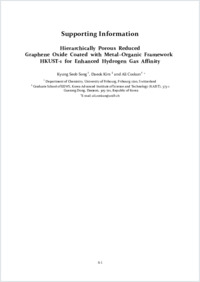Hierarchically porous reduced graphene oxide coated with metal–organic framework hkust-1 for enhanced hydrogen gas affinity
- Song, Kyung Seob Department of Chemistry, University of Fribourg, Fribourg 1700, Switzerland
- Kim, Daeok Graduate School of EEWS, Korea Advanced Institute of Science and Technology, 373-1 Guesong Dong, Daejeon 305-701, Republic of Korea
- Coskun, Ali Department of Chemistry, University of Fribourg, Fribourg 1700, Switzerland
-
28.02.2020
Published in:
- ACS Applied Nano Materials. - 2020, vol. 3, no. 2, p. 985–991
English
Metal–organic frameworks (MOFs) are crystalline porous materials that have been actively explored for various gas storage, separation, and conversion applications because of their structural tunability. While the micropores (<2 nm) in MOFs are essential for increased gas affinity, these small pores significantly decrease the mass-transport kinetics. One way to address this challenge is to develop hierarchically porous MOFs with interconnected micro-, meso-, and macropores. Whereas these MOFs can be formed by using soft/hard templates or by creating pores through postmodification, they can also be achieved by growing them on structural templates such as porous carbons, i.e., reduced graphene oxide. The latter strategy can enable the introduction of hierarchical porosity while creating a synergistic effect to simultaneously improve both the mechanical property and gas affinity by creating pores at the interface. In this direction, we demonstrated that the coating of HKUST-1 onto a hierarchically porous reduced graphene oxide (HRGO) led to the formation of a hierarchically porous structure, namely, HKUST-1@HRGO, with increased affinity toward H2 gas. While the isosteric heats of adsorption (Qst) values for H2 were found to be 7.7, 6.9, and 6.7 kJ mol–1 for HRGO, HKUST-1, and the physical mixture of HKUST-1 and HRGO, respectively, at zero coverage, that of the HKUST- 1@HRGO composite revealed a significant increase of up to 9.26 kJ mol–1, thus clearly demonstrating not only the synergetic effect between HKUST-1 and the reduced graphene oxide but also the critical role of interfacial pores as high- affinity binding sites.
- Faculty
- Faculté des sciences et de médecine
- Department
- Département de Chimie
- Language
-
- English
- Classification
- Chemistry
- License
-
License undefined
- Identifiers
-
- RERO DOC 328412
- DOI 10.1021/acsanm.9b01973
- Persistent URL
- https://folia.unifr.ch/unifr/documents/308517
Other files
Statistics
Document views: 109
File downloads:
- pdf: 270
- Supplementary material: 149

